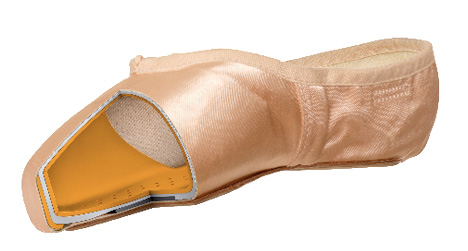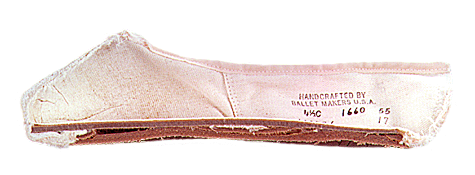 I came across a design blog post about pointe shoes integrating a hot new design material, d30 (whatever that is). I checked out the shoes and my oh my are they fancy. I’m impressed with all the detail and thought they put into the design. But I doubt they will catch on. Pointe shoes are a fascinating form of athletic gear that hasn’t changed much in over a century. I have a theory that dancers like the fact that they have to bang and cut and generally beat up a new pair of shoes before they are wearable. It’s the same masochism that draws them to ballet. What other “sport” combines ruthless auditions and rehearsals, intense competition, the ego of celebrity, the body image disorders of modeling, the social hierarchy of old European cultures, and yet is unpopular with the public and thus underfunded? You almost have to be a masochist to be a ballerina.
I came across a design blog post about pointe shoes integrating a hot new design material, d30 (whatever that is). I checked out the shoes and my oh my are they fancy. I’m impressed with all the detail and thought they put into the design. But I doubt they will catch on. Pointe shoes are a fascinating form of athletic gear that hasn’t changed much in over a century. I have a theory that dancers like the fact that they have to bang and cut and generally beat up a new pair of shoes before they are wearable. It’s the same masochism that draws them to ballet. What other “sport” combines ruthless auditions and rehearsals, intense competition, the ego of celebrity, the body image disorders of modeling, the social hierarchy of old European cultures, and yet is unpopular with the public and thus underfunded? You almost have to be a masochist to be a ballerina.
They like the old. They love to show off how little padding they wear in their shoes. The professional dancers sometimes depend on a single cobbler to make all their shoes, panicking when he retires. Here are some examples:
“Though she says the shoes fit so well they feel like slippers, Ribeiro modifies them slightly. “I bang them on the floor, squeeze the front and side, three-quarter the shank [cut the heel portion of the shank off to make it softer and more supple] and cut the tip of the satin,” she says. Depending on her schedule, Ribeiro goes through up to four pairs a week, each one getting a pre-performance kiss. “I love them,” she says. Artur Fuchs [her cobbler] is delighted to help. “I’m proud to be part of such a wonderful event,” he says.”
“New York City Ballet soloist Pascale van Kipnis switched to her 5 1/2 D Capezio “Special Make-Ups” midway through her career. Now, eight years later, van Kipnis says, “I’m sticking with these.” Van Kipnis’ shoes are handmade by Maker #7, Tony Sousa, a cobbler with 20 years’ experience. Capezio makes lasts (plastic models of the foot) for dancers who order customized shoes. The result is a shoe that fits every time. “And they last,” says van Kipnis. “I can use them for a performance and then for rehearsals the next day.” Though she could request the shank be shortened, van Kipnis three-quarters them herself. “I don’t need much support,” she says. “My feet go on pointe and stay there.”
“Grateful for her Grishko “Maya I” models, Lunkina thanked Alexander Shemenyov, her cobbler of five years, face-to-face and invited him to see her perform. Though he has several clients at companies worldwide, Shemenyov knows Lunkina’s order (size 4, width X) by heart. Once, noticing a lapse in orders, Shemenyov said he was afraid Lunkina found a new cobbler. “I felt so relieved to find out she was on maternity leave!” says Shemenyov. Soaring through 250 to 300 pairs of shoes each year, often 2 per performance, Lunkina’s only special request is to specify different shank strengths. “For Giselle I prefer a very soft shoe, for Don Quixote, a stronger shoe,” says Lunkina. “My shoes fit perfectly, I don’t need to think about my feet, I simply melt in my role.””
” After the retirement of her longtime cobbler, Royal Ballet principal Leanne Benjamin “was in a terrible state,” she says.”


There is incredible variety among traditional pointe shoes models. Students may switch models each time they get a new pair. Basically they are all constructed the same with different sizing around the different parts of the foot. There is just one other “revolutionary” new model shoe, the Gaynor Minden (on the left, standard Capezio on the right). I remember when I was on pointe and they were introduced.
I was sure it was the wave of the future. Customizable! More durable! Quieter! More comfortable! What else could any dancer ask for? Yet I was the only one in my class who tried them, and I didn’t like them as much as my old moldable, low-tech shoes. In my classes at the Arvada Center I have only seen one other girl try them. From what I hear most professionals still prefer Freeds, if they can get them (their cobblers are dying out faster than they can train new ones).
So I think these new Capulet shoes won’t make more that a little splash in the pointe shoe scene. Ballerinas are too romantic, too superstitious, and too stubborn to adapt.
(As a side note, while the shoe itself has not changed, pointe shoe accessories have evolved and flourished since I was in pointe. Everyone still used lamb’s wool for padding when I started. In the mid 1990s they introduced a gel-filled plastic pouch for you toes. This quickly changed to silicone pads, and the line expanded to all sorts of accessories: individual toe gels, capped and uncapped, various sizes, trimmable toe pouches, toes spacers, etc. After I stopped dancing they added something I always wanted – ribbons with elastic cut in where they cross behind the achilles tendon. I hear they actually don’t work that well. Now I see they invented a false arch, a beauty enhancement not far from padded push-up bras. That cracks me up.)
Leave a Reply